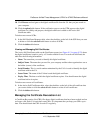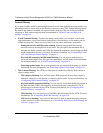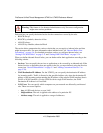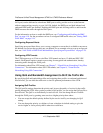
ProSecure Unified Threat Management UTM10 or UTM25 Reference Manual
Network and System Management 10-5
v1.0, September 2009
– Web object blocking. You can block the following Web component types: embedded
objects (ActiveX, Java, Flash), proxies, and cookies, and you can disable Java scripts. For
more information, see “Configuring Web Content Filtering” on page 6-23.
– Setting the size of Web files to be scanned. Scanning large Web files requires network
resources and might slow down traffic. You can specify the maximum file size that is
scanned, and if files that exceed the maximum size are skipped (which might compromise
security) or blocked. For more information, see “Configuring Web Malware Scans” on
page 6-21.
For these features (with the exception of Web object blocking and setting the size of files to be
scanned), you can set schedules to specify when Web content is filtered (see “Configuring
Web Content Filtering” on page 6-23) and configure exceptions for groups (see “Setting Web
Access Exception Rules” on page 6-41).
Source MAC Filtering
If you want to reduce outgoing traffic by preventing Internet access by certain PCs on the LAN,
you can use the source MAC filtering feature to drop the traffic received from the PCs with the
specified MAC addresses. By default, this feature is disabled; all traffic received from PCs with
any MAC address is allowed. See “Enabling Source MAC Filtering” on page 5-40 for the
procedure on how to use this feature.
Features That Increase Traffic
The following features of the UTM tend to increase the traffic load on the WAN-side:
• LAN WAN inbound rules (also referred to as port forwarding)
• DMZ WAN inbound rules (also referred to as port forwarding)
• Port triggering
• Enabling the DMZ port
• Configuring Exposed hosts
• Configuring VPN tunnels
LAN WAN Inbound Rules and DMZ WAN Inbound Rules (Port Forwarding)
The LAN WAN Rules screen and the DMZ WAN Rules screen list all existing rules for inbound
traffic (from WAN to LAN and from WAN to the DMZ). If you have not defined any rules, only
the default rule is listed. The default rule blocks all access from outside except responses to
requests from the LAN side. Any inbound rule that you create allows additional incoming traffic
and therefore increases the traffic load on the WAN side.


















